.gif)
France-Japan relations (19th century)
Encyclopedia
The development of France-Japan relations in the 19th century coincided with Japan's opening to the Western world, following two centuries of seclusion under the "Sakoku
" system and France's expansionist policy in Asia. The two countries became very important partners from the second half of the 19th century in the military, economic, legal and artistic fields. The Bakufu modernized its army through the assistance of French military missions (Jules Brunet
), and Japan later relied on France for several aspects of its modernization, particularly the development of a shipbuilding industry during the early years of the Imperial Japanese Navy
(Emile Bertin), and the development of a Legal code. France also derived part of its modern artistic inspiration
from Japanese art
, essentially through Japonism
and its influence on Impressionism
, and almost completely relied on Japan for its prosperous silk
industry.

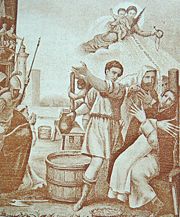 Japan had had numerous contacts with the West during the Nanban trade period in the second half of the 16th and the early 17th century. During that period, the first contacts between the French and the Japanese occurred when the samurai
Japan had had numerous contacts with the West during the Nanban trade period in the second half of the 16th and the early 17th century. During that period, the first contacts between the French and the Japanese occurred when the samurai
Hasekura Tsunenaga
landed in the southern French city of Saint-Tropez
in 1615. François Caron
, son of French Huguenot
refugees to the Netherlands
, who entered the Dutch East India Company
, and became the first person of French origin to set foot in Japan in 1619. He stayed in Japan for 20 years, where he became a Director for the company.
This period of contact ended with the persecution of the Christian faith in Japan
, leading to a near-total closure of the country to foreign interaction. In 1636, Guillaume Courtet
, a French Dominican
priest, penetrated into Japan clandestinely, against the 1613 interdiction of Christianity
. He was caught, tortured, and died in Nagasaki on September 29, 1637.
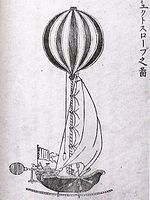 During its period of self-imposed isolation (Sakoku
During its period of self-imposed isolation (Sakoku
), Japan acquired a tremendous amount of scientific knowledge from the West, through the process of Rangaku
, in the 18th and especially the 19th century. Typically, Dutch traders in the Dejima
quarter of Nagasaki would bring to the Japanese some of the latest books about Western sciences, which would be analysed and translated by the Japanese. It is widely thought that Japan had an early start towards industrialization through this medium. French scientific knowledge was transmitted to Japan through this medium.
The first flight of a hot air balloon
by the brothers Montgolfier in France in 1783, was reported less than four years later by the Dutch in Dejima, and published in the 1787 Sayings of the Dutch. The new technology was demonstrated in 1805, almost twenty years later, when the Swiss
Johann Caspar Horner
and the Prussia
n Georg Heinrich von Langsdorff, two scientists of the Krusenstern
mission that also brought the Russian ambassador Nikolai Rezanov
to Japan, made a hot air balloon out of Japanese paper (washi
), and made a demonstration in front of about 30 Japanese delegates. Hot air balloons would mainly remain curiosities, becoming the object of numerous experiments and popular depictions, until the development of military usages during the early Meiji era.
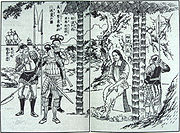 Historical events, such as the life of Napoleon, were relayed by the Dutch and were published in contemporary Japanese books. Characteristically, some historical facts could be presented exactly (the imprisonment of Napoleon "in the African island of Saint Helena"), while others could be incorrect (such as the anachronistic depiction of the British guards wearing 16th century cuirasses and weapons.
Historical events, such as the life of Napoleon, were relayed by the Dutch and were published in contemporary Japanese books. Characteristically, some historical facts could be presented exactly (the imprisonment of Napoleon "in the African island of Saint Helena"), while others could be incorrect (such as the anachronistic depiction of the British guards wearing 16th century cuirasses and weapons.
 In 1840, the Rangaku scholar Udagawa Yōan reported for the first time in details the findings and theories of Lavoisier in Japan. Accordingly, Udagawa also made numerous scientific experiments and created new scientific terms, which are still in current use in modern scientific Japanese, like , , , and .
In 1840, the Rangaku scholar Udagawa Yōan reported for the first time in details the findings and theories of Lavoisier in Japan. Accordingly, Udagawa also made numerous scientific experiments and created new scientific terms, which are still in current use in modern scientific Japanese, like , , , and .
The Rangaku scholar Takeda Ayasaburō
built the fortresses of Goryokaku
and Benten Daiba
between 1854 and 1866, using Dutch books on military architecture describing the fortification of the French architect Vauban
.
Education in the French language
started in 1808 in Nagasaki, when the Dutch
Hendrik Doeff
started to teach French to Japanese interprets. The need to learn French was identified when threatening letters were sent by the Russian government in this language.
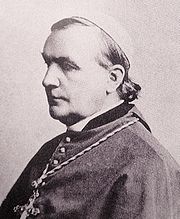 After nearly two century of strictly enforced seclusion, various contacts occurred from the middle of the 19th century as France was trying to expand its influence in Asia
After nearly two century of strictly enforced seclusion, various contacts occurred from the middle of the 19th century as France was trying to expand its influence in Asia
. After the signature of the Treaty of Nanking
by Great Britain
in 1842, both France and the United States tried to increase their efforts in the Orient.
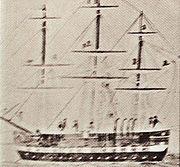 The first contacts occurred with the Ryūkyū Kingdom
The first contacts occurred with the Ryūkyū Kingdom
(modern Okinawa), a vassal of the Japanese fief of Satsuma since 1609. In 1844, a French naval expedition under Captain Fornier-Duplan onboard Alcmène visited Okinawa on April 28, 1844. Trade was denied, but Father Forcade was left behind with a Chinese translator, named Auguste Ko. Forcade and Ko remained in the Temple of Amiku, city of Tomari
, under strict surveillance, only able to learn the Japanese language from monks. After a period of one year, on May 1, 1846, the French ship Sabine, commanded by Guérin, arrived, soon followed by La Victorieuse, commanded by Rigault de Genouilly, and Cléopâtre, under Admiral Cécille. They came with the news that Pope Gregory XVI
had nominated Forcade Bishop
of Samos
and Vicar Apostolic of Japan. Cécille offered the kingdom French protection against British expansionism, but in vain, and only obtained that two missionaries could stay.
 Forcade and Ko were picked up to be used as translators in Japan, and father Leturdu was left in Tomari, soon joined by Father Mathieu Adnet. On July 24, 1846, Admiral Cécille arrived in Nagasaki, but failed in his negotiations and was denied landing, and Bishop Forcade never set foot in mainland Japan. The Ryu-Kyu court in Naha complained in early 1847 about the presence of the French missionaries, who had to be removed in 1848.
Forcade and Ko were picked up to be used as translators in Japan, and father Leturdu was left in Tomari, soon joined by Father Mathieu Adnet. On July 24, 1846, Admiral Cécille arrived in Nagasaki, but failed in his negotiations and was denied landing, and Bishop Forcade never set foot in mainland Japan. The Ryu-Kyu court in Naha complained in early 1847 about the presence of the French missionaries, who had to be removed in 1848.
France would have no further contacts with Okinawa for the next 7 years, until news came that Commodore Perry had obtained an agreement with the islands on July 11, 1854, following his treaty with Japan. A French cruiser arrived in Shimoda
in early 1855 while the USS Powhatan was still there with the ratified treaty, but was denied contacts as a formal agreement did not exist between France and Japan. France sent an embassy under Rear-Admiral Cécille onboard La Virginie in order to obtain similar advantages to those of other Western powers. A convention was signed on November 24, 1855.
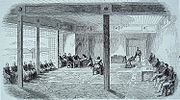
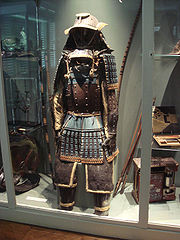
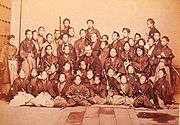 During the 19th century, numerous attempts by Western countries were made (other than by the Dutch, who already had a trade post in Dejima
During the 19th century, numerous attempts by Western countries were made (other than by the Dutch, who already had a trade post in Dejima
) to open trade and diplomatic relations with Japan. France made such an attempt in 1846 with the visit of Admiral Cécille to Nagasaki, but he was denied landing.
A Frenchman by the name of Charles Delprat is known to have lived in Nagasaki since about 1853, as a licensee to the Dutch trade. He was able to advise the initial French diplomatic efforts by Baron Gros
in Japan. He strongly recommended against Catholic prozelitism and was influential in suppressing such intentions among French diplomats. He also presented a picture of Japan as a country which had little to learn from the West: "In studying closely the customs, the institutions, the laws of the Japanese, one concludes by asking oneself if their civilization, entirely appropriate to their country, has anything to envy in ours, or that of the United States."
The formal opening of diplomatic relations with Japan however started with the American Commodore Perry in 1852-1854, when Perry threatened to bomb Edo
or blockade the country. He obtained the signature of the Convention of Kanagawa
on March 31, 1854. Soon, the 1858 Chinese defeat in the Anglo-French expedition to China further gave a concrete example of Western strength to Japanese leardership.
In 1858, the Treaty of Amity and Commerce between France and Japan
was signed in Edo
on October 9, 1858, by Jean-Baptiste Louis Gros
, the commander of the French expedition in China, opening diplomatic relations between the two countries. He was assisted by Charles de Chassiron
and Alfred de Moges
. In 1859, Gustave Duchesne de Bellecourt
arrived and became the first French representative in Japan. A French Consulate was opened that year at the Temple of Saikai-ji
, in Mita
, Edo
, at the same time as an American Consulate was established at the Temple of Zenpuku-ji
, and a British Consulate at the Temple of Tōzen-ji
.
The first trilingual Japanese dictionary incorporating French was written in 1854 by Murakami Eishun, and the first large Franco-Japanese dictionary was published in 1864. The French language was taught by Mermet de Cachon in Hakodate in 1859, or by Léon Dury in Nagasaki between 1863 to 1873. Léon Dury, who was also French Consul in Nagasaki, taught to about 50 students every year, among whom were future politicians such as Inoue Kowashi
or Saionji Kinmochi
.
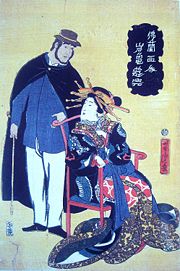 The opening of contacts between France and Japan coincided with a series biological catastrophes in Europe, as the silk industry, in which France had a leading role centered on the city of Lyon
The opening of contacts between France and Japan coincided with a series biological catastrophes in Europe, as the silk industry, in which France had a leading role centered on the city of Lyon
, was devastated with the appearance of various silkworm pandemics from Spain
: the "tacherie" or "muscardine", the "pébrine
" and the "flacherie". From 1855, France already was forced to import 61% of its raw silks. This increased to 84% in 1860. The silkworm from Japan Antheraea yamamai
proved to be the only ones capable to resist to the European illnesses and were imported to France. Japanese raw silk also proved to be of the best quality on the world market.
 Foreign silk traders started to settle in the harbour of Yokohama
Foreign silk traders started to settle in the harbour of Yokohama
, and silk trade developed. In 1859, Louis Bourret, who already had been active in China, establishes in branch office in Yokohama for silk trade. From 1860, silk traders from Lyon are recorded in Yokohama, from where they immediately dispatched raw silk and silk worm eggs to France. For this early trade they relied on British shipping, and shipments transited through London to reach Lyon. As of 1862, 12 French people were installed in Yokohama, of whom 10 were traders.
 The Japanese soon responded to these contacts by sending their own embassies to France. The Shogun
The Japanese soon responded to these contacts by sending their own embassies to France. The Shogun
sent the First Japanese Embassy to Europe, led by Takenouchi Yasunori in 1862. The mission was sent in order to learn about Western civilization, ratify treaties, and delay the opening of cities and harbour to foreign trade. Negotiation
s were made in France
, the UK, the Netherlands
, Prussia
and finally Russia
. They were almost gone an entire year.
 A Second Japanese Embassy to Europe
A Second Japanese Embassy to Europe
in 1863, in an effort to pay lip service the 1863 "Order to expel barbarians
" (攘夷実行の勅命) an edict
by Emperor Kōmei
, and the Bombardment of Shimonoseki
incidents, in a wish to close again the country to Western influence, and return to sakoku
status. The mission negotiated in vain to obtain French agreement to the closure of the harbour of Yokohama
to foreign trade.
Japan also participated to the 1867 World Fair
in Paris, having its own pavilion. The fair aroused considerable interest in Japan, and allowed many visitors to come in contact with Japanese art and techniques. Many Japanese representatives visited the Fair on this occasion, including a member of the House of the Shogun
, his younger brother Tokugawa Akitake
. The southern region of Satsuma (a regular opponent to the Bakufu) also had a representation at the World Fair, as the suzerain of the Kingdom of Naha in the Ryu Kyu islands. The Satsuma mission was composed of 20 envoys, among them 14 students, who participated to the fair, and also negotiated the purchase of weapons and mechanical looms.
to Japan in 1864. Roches himself originated from the region of Lyon, and was therefore highly knowledgeable of the issues related to the silk industry.

 Conversely, the Shogunate wished to engage in a vast program of industrial development in many areas, and in order to finance and foster it relied on the exportations of silk and the development of local resources such as mining (iron, coal, copper, silver, gold).
Conversely, the Shogunate wished to engage in a vast program of industrial development in many areas, and in order to finance and foster it relied on the exportations of silk and the development of local resources such as mining (iron, coal, copper, silver, gold).
Very soon relations developed at a high pace. The Japanese Shogunate, wishing to obtain foreign expertise in shipping obtained the dispatch of the French engineer Léonce Verny
to build the Yokosuka arsenal, Japan's first modern arsenal. Verny arrived in Japan in November 1864. In June 1865, France delivered 15 cannon
s to the Shogunate. Verny worked together with Shibata Takenaka
who visited France in 1865 to prepare for the construction of the Yokosuka (order of the machinery) arsenal and organize a French military mission to Japan. Altogether, about 100 French workers and engineers worked in Japan to establish these early industrial plants, as well as lighthouses, brick
factories, and water transportation systems. These establishments helped Japan acquire its first knowledge of modern industry.
In the educational field as well, a school to train engineers was established in Yokosuka by Verny, and a Franco-Japanese College was established in Yokohama
in 1865.
 As the Shogunate was confronted with discontent in the southern parts of the country, and foreign shipping was being fired at in violation of treaties, France participated to allied naval interventions such as the Bombardment of Shimonoseki
As the Shogunate was confronted with discontent in the southern parts of the country, and foreign shipping was being fired at in violation of treaties, France participated to allied naval interventions such as the Bombardment of Shimonoseki
in 1864 (9 British, 3 French, 4 Dutch, 1 American warships).
Following the new Tax Treaty between Western Powers and the Shogunate in 1866, Great Britain, France, the United States and the Netherlands took the opportunity to establish a stronger presence in Japan by setting up true embassies in Yokohama. France built a large colonial-style embassy on northern Naka-Dōri street.
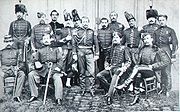 The Japanese Bakufu government, challenged at home by factions which desired the expulsion of foreign powers and the restoration of Imperial rule, also wished to develop military skills as soon as possible. The French military took a central role in the military modernization of Japan.
The Japanese Bakufu government, challenged at home by factions which desired the expulsion of foreign powers and the restoration of Imperial rule, also wished to develop military skills as soon as possible. The French military took a central role in the military modernization of Japan.
Negotiations with Napoleon III started through Shibata Takenaka
as soon as 1865. In 1867, the first French Military Mission to Japan arrived in Yokohama
, among them Captain Jules Brunet
. The military mission would engage into a training program to modernize the armies of the Shogunate, until the Boshin war
broke out a year later leading to a full-scale civil war between the Shogunate and the pro-Imperial forces. By the end of 1867, the French mission had trained a total of 10,000 men, voluntaries and recruits, organized into seven infantry regiment
s, one cavalry battalion
, and four artillery battalions. There is a well-known photograph of the Shogun Tokugawa Yoshinobu
in French uniform, taken during that period.
Foreign powers agreed to take a neutral stance during the Boshin war, but a large portion of the French mission resigned and joined the forces they had trained in their conflict against Imperial forces. French forces would become a target of Imperial forces, leading to the Kobe incident on January 11, 1868, in which a fight erupts in Akashi
between 450 samurai of the Okayama fief and French sailors, leading to the occupation of central Kobe by foreign troops. Also in 1868 eleven French sailors from the Dupleix were killed in the Sakai incident
, in Sakai
, near Osaka
, by southern rebel forces.
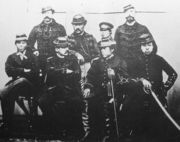 Jules Brunet
Jules Brunet
would become a leader of the military effort of the Shogunate, reorganizing its defensive efforts and accompanying it to Hokkaido until the ultimate defeat. After the fall of Edo
, Jules Brunet fled north with Enomoto Takeaki
, the leader of the Japanese Shogunate's navy, and helped set up the Ezo Republic, with Enomoto Takeaki as the President, Japan's only Republic ever. He also helped organize the defense of Hokkaidō
in the Battle of Hakodate
. Troops were structured under a hybrid Franco-Japanese leadership, with Otori Keisuke
as Commander-in-chief, and Jules Brunet as second in command. Each of the four brigades were commanded by a French officer (Fortant
, Marlin
, Cazeneuve, Bouffier
), with eight Japanese commanders as second in command of each half-brigade.
Other French officers, such as the French Navy
officer Eugène Collache
, are even known to have fought on the side of the Shogun in samurai
attire. These events, involving French officers rather than American ones, were nonetheless an inspiration for the depiction of an American hero in the movie The Last Samurai
.
 French weaponry also played a key role in the conflict. Minié rifle
French weaponry also played a key role in the conflict. Minié rifle
s were sold in quantities. The French mission brought with them 200 cases of material, including various models of artillery pieces. The French mission also brought 25 thoroughbred
Arabian horse
s, which were given to the Shogun as a present from Napoleon III.
The French-built ironclad warship Kōtetsu, originally purchased by the Shogunate to the United States
but suspended from delivery when the Boshin war started due the official neutrality of foreign powers, became the first ironclad warship of the Imperial Japanese Navy
when the Emperor Meiji
was restored, and had a decisive role in the Naval Battle of Hakodate Bay in May 1869, which marked the end of the Boshin War
, and the complete establishment of the Meiji Restoration
.
Mining Office.

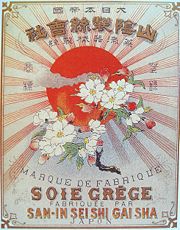 Despite its support of the losing side of the conflict during the Boshin war
Despite its support of the losing side of the conflict during the Boshin war
, France continued to play a key role in introducing modern technologies in Japan even after the 1868 Meiji Restoration
, encompassing not only the economic or military fields.
French residents such as Ludovic Savatier (who was in Japan from 1867 to 1871, and again from 1873 to 1876 as a Navy doctor based in Yokosuka) were able to witness the considerable acceleration in the modernization of Japan from that time:
The Iwakura mission
visited France from December 16, 1872, to February 17, 1873, and met with President Thiers
. The mission also visited various factories and took great interest in the various systems and technologies being employed. Nakae Chomin
, who was a member of the mission staff and the Ministry of Justice
, stayed in France to study the French legal system with the radical
republican
Emile Acollas
. Later he became a journalist
, thinker and translator and introduced French thinkers like Jean-Jacques Rousseau
to Japan.
had become the world center for silk processing, and Yokohama
had become the center for the supply of the raw material. Around 1870, Japan produced about 8.000 tons of silk, with Lyon absorbing half of this production, and 13.000 tons in 1910, becoming the first world producer of silk, although the United States
had overtaken France as the first importer of Japanese silk from around 1885. Silk exports allowed Japan to gather currencies to purchase foreign goods and technologies.
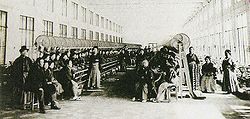 In 1870, Henri Pelegrin was invited to direct the construction of Japan's first gas-lightning system in the streets of Nihonbashi
In 1870, Henri Pelegrin was invited to direct the construction of Japan's first gas-lightning system in the streets of Nihonbashi
, Ginza
and Yokohama
. In 1872, Paul Brunat opened the first modern Japanese silk spinning factory at Tomioka
. Three craftsmen from the Nishijin weaving district in Kyoto, Sakura tsuneshichi, Inoue Ihee and Yoshida Chushichi traveled to Lyon. They traveled back to Japan in 1873, importing a Jacquard loom
. Tomioka became Japan's first large-scale silk-reeling factory, and an example for the industrialization of the country.
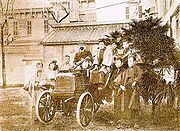 France was also highly regarded for the quality of its Legal system, and was used as an example to establish the country's legal code. Georges Bousquet taught law from 1871 to 1876. The legal expert Gustave Emile Boissonade
France was also highly regarded for the quality of its Legal system, and was used as an example to establish the country's legal code. Georges Bousquet taught law from 1871 to 1876. The legal expert Gustave Emile Boissonade
was sent to Japan in 1873 to help build a modern legal system, and helped the country through 22 years.
Japan again participated to the 1878 World Fair
in Paris. Every time France was deemed to have a specific expertise, its technologies were introduced. In 1882, the first tram
ways were introduced from France and started to function at Asakusa
, and between Shinbashi
and Ueno
. In 1898, the first automobile
was introduced in Japan, a French Panhard-Levassor.
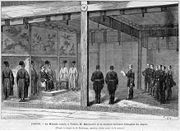 Despite the French defeat during the Franco-Prussian war
Despite the French defeat during the Franco-Prussian war
(1870–1871), France was still considered as an example in the military field as well, and was used as a model for the development of the Imperial Japanese Army
. As soon as 1872, a second French Military Mission to Japan (1872-1880)
was invited, with the objective of organizing the army and establishing a military educational system. The mission established the Ichigaya Military Academy (市ヶ谷陸軍士官校), built in 1874, on the ground of today's Ministry of Defense. In 1877, the modernized Imperial Japanese Army would defeat the Satsuma rebellion
led by Saigo Takamori
.
A third French Military Mission to Japan (1884-1889)
composed of five men started in 1884, but this time the Japanese also involved some German officers for the training of the General Staff
from 1886 to 1889 (the Meckel Mission
), although the training of the rest of the Officers remained to the French mission. After 1894, Japan did not employ any foreign military instructor, until 1918 when the country welcomed the fourth French Military Mission to Japan (1918-1919)
, with the objective of acquiring technologies and techniques in the burgeoning area of military aviation
.
.jpg)
The French Navy leading engineer Emile Bertin was invited to Japan for four years (from 1886 to 1890) to reinforce the Imperial Japanese Navy
, and direct the construction of the arsenals of Kure
and Sasebo
. For the first time, with French assistance, the Japanese were able to build a full fleet, some of it built in Japan, some of it in France and a few other European nations. The three cruisers designed by Emile Bertin (Matsushima
, Itsukushima
, and Hashidate
) were equipped with 12.6in (32 cm) Canet guns
, an extremely powerful weapon for the time. These efforts contributed to the Japanese victory in the First Sino-Japanese war
.
This period also allowed Japan "to embrace the revolutionary new technologies embodied in torpedoes, torpedo-boats and mines, of which the French at the time were probably the world's best exponents".
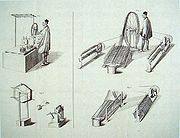 In a rather rare case of “reverse Rangaku
In a rather rare case of “reverse Rangaku
” (that is, the science of isolationist Japan making its way to the West), an 1803 treatise on the raising of silk worms and manufacture of silk
, the was brought to Europe by von Siebold and translated into French and Italian in 1848, contributing to the development of the silk industry in Europe.
In 1868, Léon de Rosny published a translation of a Japanese work on silk worms: Traité de l'éducation des vers a soie au Japon. In 1874, Ernest de Bavier published a detailed study of the silk industry in Japan (La sericulture, le commerce des soies et des graines et l'industrie de la soie au Japon, 1874).
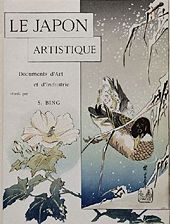
Japanese art
decisively influenced the art of France, and the art of the West in general during the 19th century. From the 1860s, ukiyo-e
, Japanese wood-block prints, became a source of inspiration for many European impressionist painters
in France and the rest of the West, and eventually for Art Nouveau
and Cubism
. Artists were especially affected by the lack of perspective and shadow, the flat areas of strong colour, the compositional freedom in placing the subject off-centre, with mostly low diagonal axes to the background.
 As Japan opened to Western influence, numerous Western travellers visited the country, taking a great interest in the arts and culture. The French writer Pierre Loti
As Japan opened to Western influence, numerous Western travellers visited the country, taking a great interest in the arts and culture. The French writer Pierre Loti
wrote one of his most famous novels Madame Chrysanthème (1887) based on his encounter with a young Japanese woman during a month, a precursor to Madame Butterfly and Miss Saigon
and a work that is a combination of narrative and travelog. Another famous Frenchman who visited Japan was Émile Étienne Guimet
, who wrote extensively on Asian cultures and Japan in particular, and would create the Guimet Museum
upon his return.
Sakoku
was the foreign relations policy of Japan under which no foreigner could enter nor could any Japanese leave the country on penalty of death. The policy was enacted by the Tokugawa shogunate under Tokugawa Iemitsu through a number of edicts and policies from 1633–39 and remained in effect until...
" system and France's expansionist policy in Asia. The two countries became very important partners from the second half of the 19th century in the military, economic, legal and artistic fields. The Bakufu modernized its army through the assistance of French military missions (Jules Brunet
Jules Brunet
Jules Brunet was a French officer who played an active role in Mexico and Japan, and later became a General and Chief of Staff of the French Minister of War in 1898...
), and Japan later relied on France for several aspects of its modernization, particularly the development of a shipbuilding industry during the early years of the Imperial Japanese Navy
Imperial Japanese Navy
The Imperial Japanese Navy was the navy of the Empire of Japan from 1869 until 1947, when it was dissolved following Japan's constitutional renunciation of the use of force as a means of settling international disputes...
(Emile Bertin), and the development of a Legal code. France also derived part of its modern artistic inspiration
Artistic inspiration
Inspiration refers to an unconscious burst of creativity in a literary, musical, or other artistic endeavour. Literally, the word means "breathed upon," and it has its origins in both Hellenism and Hebraism. The Greeks believed that inspiration came from the muses, as well as the gods Apollo and...
from Japanese art
Japanese art
Japanese art covers a wide range of art styles and media, including ancient pottery, sculpture in wood and bronze, ink painting on silk and paper and more recently manga, cartoon, along with a myriad of other types of works of art...
, essentially through Japonism
Japonism
Japonism, or Japonisme, the original French term, was first used in 1872 by Jules Claretie in his book L'Art Francais en 1872 and by Philippe Burty in Japanisme III. La Renaissance Literaire et Artistique in the same year...
and its influence on Impressionism
Impressionism
Impressionism was a 19th-century art movement that originated with a group of Paris-based artists whose independent exhibitions brought them to prominence during the 1870s and 1880s...
, and almost completely relied on Japan for its prosperous silk
Silk
Silk is a natural protein fiber, some forms of which can be woven into textiles. The best-known type of silk is obtained from the cocoons of the larvae of the mulberry silkworm Bombyx mori reared in captivity...
industry.
Context


Samurai
is the term for the military nobility of pre-industrial Japan. According to translator William Scott Wilson: "In Chinese, the character 侍 was originally a verb meaning to wait upon or accompany a person in the upper ranks of society, and this is also true of the original term in Japanese, saburau...
Hasekura Tsunenaga
Hasekura Tsunenaga
Hasekura Rokuemon Tsunenaga or was a Japanese samurai and retainer of Date Masamune, the daimyo of Sendai....
landed in the southern French city of Saint-Tropez
Saint-Tropez
Saint-Tropez is a town, 104 km to the east of Marseille, in the Var department of the Provence-Alpes-Côte d'Azur region of southeastern France. It is also the principal town in the canton of Saint-Tropez....
in 1615. François Caron
François Caron
François Caron was a French Huguenot refugee to the Netherlands who served the Dutch East India Company for 30 years, rising from cabin boy to Director-General at Batavia , only one grade below Governor-General...
, son of French Huguenot
Huguenot
The Huguenots were members of the Protestant Reformed Church of France during the 16th and 17th centuries. Since the 17th century, people who formerly would have been called Huguenots have instead simply been called French Protestants, a title suggested by their German co-religionists, the...
refugees to the Netherlands
Netherlands
The Netherlands is a constituent country of the Kingdom of the Netherlands, located mainly in North-West Europe and with several islands in the Caribbean. Mainland Netherlands borders the North Sea to the north and west, Belgium to the south, and Germany to the east, and shares maritime borders...
, who entered the Dutch East India Company
Dutch East India Company
The Dutch East India Company was a chartered company established in 1602, when the States-General of the Netherlands granted it a 21-year monopoly to carry out colonial activities in Asia...
, and became the first person of French origin to set foot in Japan in 1619. He stayed in Japan for 20 years, where he became a Director for the company.
This period of contact ended with the persecution of the Christian faith in Japan
Persecution of Christians in Japan
After the first landing of Portuguese sailors in Japan in 1542, Christian proselyting led by Francisco Xavier started. In the following decades, many thousands of Japanese, including some princes' families, converted to Roman Catholicism in the form known as Kirishitan with the cooperation of the...
, leading to a near-total closure of the country to foreign interaction. In 1636, Guillaume Courtet
Guillaume Courtet
Guillaume Courtet was a French Dominican priest who has been described as the first Frenchman to have visited Japan. He was martyred in 1637 and canonized in 1987.-Career:Courtet was born in Sérignan, near Béziers, in 1589 or 1590...
, a French Dominican
Dominican Order
The Order of Preachers , after the 15th century more commonly known as the Dominican Order or Dominicans, is a Catholic religious order founded by Saint Dominic and approved by Pope Honorius III on 22 December 1216 in France...
priest, penetrated into Japan clandestinely, against the 1613 interdiction of Christianity
Christianity
Christianity is a monotheistic religion based on the life and teachings of Jesus as presented in canonical gospels and other New Testament writings...
. He was caught, tortured, and died in Nagasaki on September 29, 1637.
Diffusion of French learning to Japan

Sakoku
was the foreign relations policy of Japan under which no foreigner could enter nor could any Japanese leave the country on penalty of death. The policy was enacted by the Tokugawa shogunate under Tokugawa Iemitsu through a number of edicts and policies from 1633–39 and remained in effect until...
), Japan acquired a tremendous amount of scientific knowledge from the West, through the process of Rangaku
Rangaku
Rangaku is a body of knowledge developed by Japan through its contacts with the Dutch enclave of Dejima, which allowed Japan to keep abreast of Western technology and medicine in the period when the country was closed to foreigners, 1641–1853, because of the Tokugawa shogunate’s policy of national...
, in the 18th and especially the 19th century. Typically, Dutch traders in the Dejima
Dejima
was a small fan-shaped artificial island built in the bay of Nagasaki in 1634. This island, which was formed by digging a canal through a small peninsula, remained as the single place of direct trade and exchange between Japan and the outside world during the Edo period. Dejima was built to...
quarter of Nagasaki would bring to the Japanese some of the latest books about Western sciences, which would be analysed and translated by the Japanese. It is widely thought that Japan had an early start towards industrialization through this medium. French scientific knowledge was transmitted to Japan through this medium.
The first flight of a hot air balloon
Hot air balloon
The hot air balloon is the oldest successful human-carrying flight technology. It is in a class of aircraft known as balloon aircraft. On November 21, 1783, in Paris, France, the first untethered manned flight was made by Jean-François Pilâtre de Rozier and François Laurent d'Arlandes in a hot air...
by the brothers Montgolfier in France in 1783, was reported less than four years later by the Dutch in Dejima, and published in the 1787 Sayings of the Dutch. The new technology was demonstrated in 1805, almost twenty years later, when the Swiss
Switzerland
Switzerland name of one of the Swiss cantons. ; ; ; or ), in its full name the Swiss Confederation , is a federal republic consisting of 26 cantons, with Bern as the seat of the federal authorities. The country is situated in Western Europe,Or Central Europe depending on the definition....
Johann Caspar Horner
Johann Caspar Horner
Johann Caspar Horner was a Swiss physicist and astronomer.In 1805 Johann Caspar Horner visited Japan with the Prussian Georg Heinrich von Langsdorff, as a scientist to the Kruzenshtern mission that also brought the Russian ambassador Nikolai Rezanov to Japan.Horner made a hot air balloon out of...
and the Prussia
Prussia
Prussia was a German kingdom and historic state originating out of the Duchy of Prussia and the Margraviate of Brandenburg. For centuries, the House of Hohenzollern ruled Prussia, successfully expanding its size by way of an unusually well-organized and effective army. Prussia shaped the history...
n Georg Heinrich von Langsdorff, two scientists of the Krusenstern
Adam Johann von Krusenstern
Adam Johann Ritter von Krusenstern , was an admiral and explorer, who led the first Russian circumnavigation of the globe.- Life :...
mission that also brought the Russian ambassador Nikolai Rezanov
Nikolai Rezanov
Nikolay Petrovich Rezanov was a Russian nobleman and statesman who promoted the project of Russian colonization of Alaska and California. One of the ten barons of Russia, he was the first Russian ambassador to Japan , and participated in the first Russian circumnavigation of the globe ,...
to Japan, made a hot air balloon out of Japanese paper (washi
Washi
is a type of paper made in Japan. Washi is commonly made using fibers from the bark of the gampi tree, the mitsumata shrub , or the paper mulberry, but also can be made using bamboo, hemp, rice, and wheat...
), and made a demonstration in front of about 30 Japanese delegates. Hot air balloons would mainly remain curiosities, becoming the object of numerous experiments and popular depictions, until the development of military usages during the early Meiji era.


The Rangaku scholar Takeda Ayasaburō
Takeda Ayasaburo
, was a Japanese Rangaku scholar, and the architect of the fortress of Goryōkaku in Hokkaidō.Takeda was born in the Ōzu Domain in 1827. He studied medicine, Western sciences , navigation, military architecture. He was a student of Ogata Kōan and Sakuma Shōzan...
built the fortresses of Goryokaku
Goryokaku
is a star fort in the city of Hakodate in southern Hokkaidō, Japan. It was the main fortress of the short-lived Republic of Ezo.- History :Built by the Tokugawa shogunate in 1857-1866, it was located in the center of the port of Hakodate, on the island of Hokkaidō...
and Benten Daiba
Benten Daiba
was a key fortress of the Republic of Ezo in 1868-1869. It was located at the entrance of the bay of Hakodate, in the northern island of Hokkaidō, Japan....
between 1854 and 1866, using Dutch books on military architecture describing the fortification of the French architect Vauban
Vauban
Sébastien Le Prestre, Seigneur de Vauban and later Marquis de Vauban , commonly referred to as Vauban, was a Marshal of France and the foremost military engineer of his age, famed for his skill in both designing fortifications and breaking through them...
.
Education in the French language
French language
French is a Romance language spoken as a first language in France, the Romandy region in Switzerland, Wallonia and Brussels in Belgium, Monaco, the regions of Quebec and Acadia in Canada, and by various communities elsewhere. Second-language speakers of French are distributed throughout many parts...
started in 1808 in Nagasaki, when the Dutch
Netherlands
The Netherlands is a constituent country of the Kingdom of the Netherlands, located mainly in North-West Europe and with several islands in the Caribbean. Mainland Netherlands borders the North Sea to the north and west, Belgium to the south, and Germany to the east, and shares maritime borders...
Hendrik Doeff
Hendrik Doeff
Hendrik Doeff was the Dutch commissioner in the Dejima trading post in Nagasaki, during the first years of the 19th century.-Biography:...
started to teach French to Japanese interprets. The need to learn French was identified when threatening letters were sent by the Russian government in this language.
First contacts with Okinawa (1844)

Asia
Asia is the world's largest and most populous continent, located primarily in the eastern and northern hemispheres. It covers 8.7% of the Earth's total surface area and with approximately 3.879 billion people, it hosts 60% of the world's current human population...
. After the signature of the Treaty of Nanking
Treaty of Nanking
The Treaty of Nanking was signed on 29 August 1842 to mark the end of the First Opium War between the United Kingdom of Great Britain and Ireland and the Qing Dynasty of China...
by Great Britain
Great Britain
Great Britain or Britain is an island situated to the northwest of Continental Europe. It is the ninth largest island in the world, and the largest European island, as well as the largest of the British Isles...
in 1842, both France and the United States tried to increase their efforts in the Orient.

Ryukyu Kingdom
The Ryūkyū Kingdom was an independent kingdom which ruled most of the Ryukyu Islands from the 15th century to the 19th century. The Kings of Ryūkyū unified Okinawa Island and extended the kingdom to the Amami Islands in modern-day Kagoshima Prefecture, and the Sakishima Islands near Taiwan...
(modern Okinawa), a vassal of the Japanese fief of Satsuma since 1609. In 1844, a French naval expedition under Captain Fornier-Duplan onboard Alcmène visited Okinawa on April 28, 1844. Trade was denied, but Father Forcade was left behind with a Chinese translator, named Auguste Ko. Forcade and Ko remained in the Temple of Amiku, city of Tomari
Tomari, Okinawa
is a neighborhood in Naha, Okinawa Prefecture, Japan, where the Tomari Terminal of the port of Naha is located. The terminal is used for ferries and passenger vessels which connect Naha and neighboring islands....
, under strict surveillance, only able to learn the Japanese language from monks. After a period of one year, on May 1, 1846, the French ship Sabine, commanded by Guérin, arrived, soon followed by La Victorieuse, commanded by Rigault de Genouilly, and Cléopâtre, under Admiral Cécille. They came with the news that Pope Gregory XVI
Pope Gregory XVI
Pope Gregory XVI , born Bartolomeo Alberto Cappellari, named Mauro as a member of the religious order of the Camaldolese, was Pope of the Catholic Church from 1831 to 1846...
had nominated Forcade Bishop
Bishop
A bishop is an ordained or consecrated member of the Christian clergy who is generally entrusted with a position of authority and oversight. Within the Catholic Church, Eastern Orthodox, Oriental Orthodox Churches, in the Assyrian Church of the East, in the Independent Catholic Churches, and in the...
of Samos
Samoš
Samoš is a village in Serbia. It is situated in the Kovačica municipality, in the South Banat District, Vojvodina province. The village has a Serb ethnic majority and its population numbering 1,247 people .-See also:...
and Vicar Apostolic of Japan. Cécille offered the kingdom French protection against British expansionism, but in vain, and only obtained that two missionaries could stay.

France would have no further contacts with Okinawa for the next 7 years, until news came that Commodore Perry had obtained an agreement with the islands on July 11, 1854, following his treaty with Japan. A French cruiser arrived in Shimoda
Shimoda
Shimoda can mean:* Places in Japan:** Shimoda, Shizuoka, a city in Shizuoka Prefecture** Shimoda, Aomori, a town in Aomori Prefecture* Treaty of Shimoda , between Japan and Russia* Shimoda Toyomatsu, an early Japanese Scouting notable...
in early 1855 while the USS Powhatan was still there with the ratified treaty, but was denied contacts as a formal agreement did not exist between France and Japan. France sent an embassy under Rear-Admiral Cécille onboard La Virginie in order to obtain similar advantages to those of other Western powers. A convention was signed on November 24, 1855.
Contacts with mainland Japan (1858)



Dejima
was a small fan-shaped artificial island built in the bay of Nagasaki in 1634. This island, which was formed by digging a canal through a small peninsula, remained as the single place of direct trade and exchange between Japan and the outside world during the Edo period. Dejima was built to...
) to open trade and diplomatic relations with Japan. France made such an attempt in 1846 with the visit of Admiral Cécille to Nagasaki, but he was denied landing.
A Frenchman by the name of Charles Delprat is known to have lived in Nagasaki since about 1853, as a licensee to the Dutch trade. He was able to advise the initial French diplomatic efforts by Baron Gros
Jean-Baptiste Louis Gros
Jean-Baptiste Louis Gros was a French ambassador and one of the first daguerrotypists. Baron and French chargé d'affaires in Bogotá , Athens and Ambassador to London - during which period he also travelled to China and Japan in 1857 and 1858 — he produced many famous daguerrotypes — chief among...
in Japan. He strongly recommended against Catholic prozelitism and was influential in suppressing such intentions among French diplomats. He also presented a picture of Japan as a country which had little to learn from the West: "In studying closely the customs, the institutions, the laws of the Japanese, one concludes by asking oneself if their civilization, entirely appropriate to their country, has anything to envy in ours, or that of the United States."
The formal opening of diplomatic relations with Japan however started with the American Commodore Perry in 1852-1854, when Perry threatened to bomb Edo
Edo
, also romanized as Yedo or Yeddo, is the former name of the Japanese capital Tokyo, and was the seat of power for the Tokugawa shogunate which ruled Japan from 1603 to 1868...
or blockade the country. He obtained the signature of the Convention of Kanagawa
Convention of Kanagawa
On March 31, 1854, the or was concluded between Commodore Matthew C. Perry of the U.S. Navy and the Tokugawa shogunate.-Treaty of Peace and Amity :...
on March 31, 1854. Soon, the 1858 Chinese defeat in the Anglo-French expedition to China further gave a concrete example of Western strength to Japanese leardership.
In 1858, the Treaty of Amity and Commerce between France and Japan
Treaty of Amity and Commerce between France and Japan
The Treaty of Amity and Commerce between France and Japan was signed in Edo on October 9, 1858, by Jean-Baptiste Louis Gros, the commander of the French expedition in China, assisted by Charles de Chassiron and Alfred de Moges, opening diplomatic relations between the two countries...
was signed in Edo
Edo
, also romanized as Yedo or Yeddo, is the former name of the Japanese capital Tokyo, and was the seat of power for the Tokugawa shogunate which ruled Japan from 1603 to 1868...
on October 9, 1858, by Jean-Baptiste Louis Gros
Jean-Baptiste Louis Gros
Jean-Baptiste Louis Gros was a French ambassador and one of the first daguerrotypists. Baron and French chargé d'affaires in Bogotá , Athens and Ambassador to London - during which period he also travelled to China and Japan in 1857 and 1858 — he produced many famous daguerrotypes — chief among...
, the commander of the French expedition in China, opening diplomatic relations between the two countries. He was assisted by Charles de Chassiron
Charles de Chassiron
Baron Charles Gustave Martin de Chassiron was a French diplomat of the 19th century. He travelled to China and Japan as one of the two Attachés of the French Embassy under Baron Gros, with the title of "Detaché extraordinaire en Chine et au Japon" from 1858 to 1860., together with Marquis Alfred...
and Alfred de Moges
Alfred de Moges
Alfred, Marquis de Moges was a French diplomat of the 19th century. In 1858 he accompanied Charles de Chassiron and Jean-Baptiste Louis Gros to sign the Treaty of Amity and Commerce between France and Japan in Edo on October 9, 1858.-Works:* Recollections of Baron Gros's Embassy to China and Japan...
. In 1859, Gustave Duchesne de Bellecourt
Gustave Duchesne de Bellecourt
Gustave Duchesne, Prince de Bellecourt was a 19th-century French diplomat who was active in Asia, and especially in Japan. He was the first French official representative in Japan from 1859 to 1864, following the signature of the Treaty of Amity and Commerce between France and Japan in...
arrived and became the first French representative in Japan. A French Consulate was opened that year at the Temple of Saikai-ji
Saikai-ji
, more commonly , is a Japanese temple in 4-16-23, Mita, Minato, Tokyo . Its religious sect and principal image are Pure Land Buddhism and Amitābha respectively....
, in Mita
Mita
-Surname:*Ciriaco de Mita, Italian politician*Hikaru Mita , Japanese football player*Hiroko Mita, actress*Masayuki Mita , former Japanese football player.*Merata Mita , New Zealand filmmaker*Munesuke Mita, sociologist...
, Edo
Edo
, also romanized as Yedo or Yeddo, is the former name of the Japanese capital Tokyo, and was the seat of power for the Tokugawa shogunate which ruled Japan from 1603 to 1868...
, at the same time as an American Consulate was established at the Temple of Zenpuku-ji
Zenpuku-ji
Zenpuku-ji , also known as Azabu-san , is a Jōdo Shinshū temple located in the Azabu district of Tokyo, Japan. It is one of the oldest Tokyo temples, after Asakusa.Founded by Kūkai in 824, Zenpuku-ji was originally a Shingon temple...
, and a British Consulate at the Temple of Tōzen-ji
Tozen-ji
Tōzen-ji is a temple in Takanawa, Minato, Tokyo, Japan. It belongs to the Rinzai sect of Zen Buddhism which has its headquarters at Myoshin-ji in Kyoto.In 1610, Ryonan-zenji founded it at Akasaka and in 1636 it was relocated to its present location...
.
The first trilingual Japanese dictionary incorporating French was written in 1854 by Murakami Eishun, and the first large Franco-Japanese dictionary was published in 1864. The French language was taught by Mermet de Cachon in Hakodate in 1859, or by Léon Dury in Nagasaki between 1863 to 1873. Léon Dury, who was also French Consul in Nagasaki, taught to about 50 students every year, among whom were future politicians such as Inoue Kowashi
Inoue Kowashi
Viscount was a statesman in Meiji period Japan.- Early life :Inoue was born into a samurai family in Higo Province , as the third son of Karō Iida Gongobei. In 1866 Kowashi was adopted by Inoue Shigesaburō, another retainer of the Nagaoka daimyō...
or Saionji Kinmochi
Saionji Kinmochi
Prince was a Japanese politician, statesman and twice Prime Minister of Japan. His title does not signify the son of an emperor, but the highest rank of Japanese hereditary nobility; he was elevated from marquis to prince in 1920...
.
Development of trade relations

Lyon
Lyon , is a city in east-central France in the Rhône-Alpes region, situated between Paris and Marseille. Lyon is located at from Paris, from Marseille, from Geneva, from Turin, and from Barcelona. The residents of the city are called Lyonnais....
, was devastated with the appearance of various silkworm pandemics from Spain
Spain
Spain , officially the Kingdom of Spain languages]] under the European Charter for Regional or Minority Languages. In each of these, Spain's official name is as follows:;;;;;;), is a country and member state of the European Union located in southwestern Europe on the Iberian Peninsula...
: the "tacherie" or "muscardine", the "pébrine
Pébrine
Pébrine is a disease of silkworms, which is caused by microsporidian parasites, mainly Nosema bombycis and to a lesser extent Variomorpha, Pleistophora and Thelophania species....
" and the "flacherie". From 1855, France already was forced to import 61% of its raw silks. This increased to 84% in 1860. The silkworm from Japan Antheraea yamamai
Antheraea yamamai
The Japanese Silk Moth or Japanese Oak Silkmoth is a moth of the Saturniidae family. It is endemic to Japan, but has been imported to Europe for silk production and is now found in South-Eastern Europe, mainly in Austria, North-Eastern Italy and the Balkan...
proved to be the only ones capable to resist to the European illnesses and were imported to France. Japanese raw silk also proved to be of the best quality on the world market.

Yokohama
is the capital city of Kanagawa Prefecture and the second largest city in Japan by population after Tokyo and most populous municipality of Japan. It lies on Tokyo Bay, south of Tokyo, in the Kantō region of the main island of Honshu...
, and silk trade developed. In 1859, Louis Bourret, who already had been active in China, establishes in branch office in Yokohama for silk trade. From 1860, silk traders from Lyon are recorded in Yokohama, from where they immediately dispatched raw silk and silk worm eggs to France. For this early trade they relied on British shipping, and shipments transited through London to reach Lyon. As of 1862, 12 French people were installed in Yokohama, of whom 10 were traders.
Japanese embassies to France (1862, 1863, 1867)

Shogun
A was one of the hereditary military dictators of Japan from 1192 to 1867. In this period, the shoguns, or their shikken regents , were the de facto rulers of Japan though they were nominally appointed by the emperor...
sent the First Japanese Embassy to Europe, led by Takenouchi Yasunori in 1862. The mission was sent in order to learn about Western civilization, ratify treaties, and delay the opening of cities and harbour to foreign trade. Negotiation
Negotiation
Negotiation is a dialogue between two or more people or parties, intended to reach an understanding, resolve point of difference, or gain advantage in outcome of dialogue, to produce an agreement upon courses of action, to bargain for individual or collective advantage, to craft outcomes to satisfy...
s were made in France
France
The French Republic , The French Republic , The French Republic , (commonly known as France , is a unitary semi-presidential republic in Western Europe with several overseas territories and islands located on other continents and in the Indian, Pacific, and Atlantic oceans. Metropolitan France...
, the UK, the Netherlands
Netherlands
The Netherlands is a constituent country of the Kingdom of the Netherlands, located mainly in North-West Europe and with several islands in the Caribbean. Mainland Netherlands borders the North Sea to the north and west, Belgium to the south, and Germany to the east, and shares maritime borders...
, Prussia
Prussia
Prussia was a German kingdom and historic state originating out of the Duchy of Prussia and the Margraviate of Brandenburg. For centuries, the House of Hohenzollern ruled Prussia, successfully expanding its size by way of an unusually well-organized and effective army. Prussia shaped the history...
and finally Russia
Russia
Russia or , officially known as both Russia and the Russian Federation , is a country in northern Eurasia. It is a federal semi-presidential republic, comprising 83 federal subjects...
. They were almost gone an entire year.

Second Japanese Embassy to Europe (1863)
The Second Japanese Embassy to Europe , also called the Ikeda Mission, was sent on December 29 1863 by the Tokugawa shogunate. The head of the mission was Ikeda Nagaoki, governor of small villages of Ibara, Bitchū Province...
in 1863, in an effort to pay lip service the 1863 "Order to expel barbarians
Order to expel barbarians
The was an edict issued by the Japanese Emperor Kōmei in 1863 against the Westernization of Japan following the opening of the country by Commodore Perry in 1854.-The order:...
" (攘夷実行の勅命) an edict
Edict
An edict is an announcement of a law, often associated with monarchism. The Pope and various micronational leaders are currently the only persons who still issue edicts.-Notable edicts:...
by Emperor Kōmei
Emperor Komei
was the 121st emperor of Japan, according to the traditional order of succession. Kōmei's reign spanned the years from 1846 through 1867.-Genealogy:Before Kōmei's accession to the Chrysanthemum Throne, his personal name was ;, his title was ....
, and the Bombardment of Shimonoseki
Bombardment of Shimonoseki
The Battles for Shimonoseki refers to a series of military engagements in 1863 and 1864, fought to control Shimonoseki Straits by joint naval forces from the Great Britain, France, the Netherlands and the United States, against the Japanese feudal domain of Chōshū, which took place off and on the...
incidents, in a wish to close again the country to Western influence, and return to sakoku
Sakoku
was the foreign relations policy of Japan under which no foreigner could enter nor could any Japanese leave the country on penalty of death. The policy was enacted by the Tokugawa shogunate under Tokugawa Iemitsu through a number of edicts and policies from 1633–39 and remained in effect until...
status. The mission negotiated in vain to obtain French agreement to the closure of the harbour of Yokohama
Yokohama
is the capital city of Kanagawa Prefecture and the second largest city in Japan by population after Tokyo and most populous municipality of Japan. It lies on Tokyo Bay, south of Tokyo, in the Kantō region of the main island of Honshu...
to foreign trade.
Japan also participated to the 1867 World Fair
Exposition Universelle (1867)
The Exposition Universelle of 1867 was a World Exposition held in Paris, France, in 1867.-Conception:In 1864, Emperor Napoleon III decreed that an international exposition should be held in Paris in 1867. A commission was appointed with Prince Jerome Napoleon as president, under whose direction...
in Paris, having its own pavilion. The fair aroused considerable interest in Japan, and allowed many visitors to come in contact with Japanese art and techniques. Many Japanese representatives visited the Fair on this occasion, including a member of the House of the Shogun
Shogun
A was one of the hereditary military dictators of Japan from 1192 to 1867. In this period, the shoguns, or their shikken regents , were the de facto rulers of Japan though they were nominally appointed by the emperor...
, his younger brother Tokugawa Akitake
Tokugawa Akitake
was a younger brother of the Japanese Shogun Tokugawa Yoshinobu. He was born in Komagome, Tokyo, as the 18th son of Tokugawa Nariaki. Initially lord of Aizu, he became lord of Shimizu before his departure for France.-Biography:...
. The southern region of Satsuma (a regular opponent to the Bakufu) also had a representation at the World Fair, as the suzerain of the Kingdom of Naha in the Ryu Kyu islands. The Satsuma mission was composed of 20 envoys, among them 14 students, who participated to the fair, and also negotiated the purchase of weapons and mechanical looms.
Major exchanges at the end of the Shogunate (1864-1867)
France decided to reinforce and formalize links with Japan by sending its second representative Léon RochesLéon Roches
Léon Roches was a representative of the French government in Japan from 1864 to 1868.Léon Roches was a student at the Lycée de Tournon in Grenoble, and followed an education in Law...
to Japan in 1864. Roches himself originated from the region of Lyon, and was therefore highly knowledgeable of the issues related to the silk industry.


Very soon relations developed at a high pace. The Japanese Shogunate, wishing to obtain foreign expertise in shipping obtained the dispatch of the French engineer Léonce Verny
Léonce Verny
François Léonce Verny, was a French officer and naval engineer who directed the construction of the Yokosuka Naval Arsenal in Japan, as well as many related modern infrastructure projects from 1865 to 1876, thus helping jump-start Japan's modernization.-Early life:Léonce Verny was born in Aubenas,...
to build the Yokosuka arsenal, Japan's first modern arsenal. Verny arrived in Japan in November 1864. In June 1865, France delivered 15 cannon
Cannon
A cannon is any piece of artillery that uses gunpowder or other usually explosive-based propellents to launch a projectile. Cannon vary in caliber, range, mobility, rate of fire, angle of fire, and firepower; different forms of cannon combine and balance these attributes in varying degrees,...
s to the Shogunate. Verny worked together with Shibata Takenaka
Shibata Takenaka
was an emissary for Japan who visited France in 1865 to help prepare for the construction of the Yokosuka arsenal with French support.On behalf of the Shogunate, Shibata requested both the United Kingdom and France to send a military mission for training in Western warfare...
who visited France in 1865 to prepare for the construction of the Yokosuka (order of the machinery) arsenal and organize a French military mission to Japan. Altogether, about 100 French workers and engineers worked in Japan to establish these early industrial plants, as well as lighthouses, brick
Brick
A brick is a block of ceramic material used in masonry construction, usually laid using various kinds of mortar. It has been regarded as one of the longest lasting and strongest building materials used throughout history.-History:...
factories, and water transportation systems. These establishments helped Japan acquire its first knowledge of modern industry.
In the educational field as well, a school to train engineers was established in Yokosuka by Verny, and a Franco-Japanese College was established in Yokohama
Yokohama
is the capital city of Kanagawa Prefecture and the second largest city in Japan by population after Tokyo and most populous municipality of Japan. It lies on Tokyo Bay, south of Tokyo, in the Kantō region of the main island of Honshu...
in 1865.

Bombardment of Shimonoseki
The Battles for Shimonoseki refers to a series of military engagements in 1863 and 1864, fought to control Shimonoseki Straits by joint naval forces from the Great Britain, France, the Netherlands and the United States, against the Japanese feudal domain of Chōshū, which took place off and on the...
in 1864 (9 British, 3 French, 4 Dutch, 1 American warships).
Following the new Tax Treaty between Western Powers and the Shogunate in 1866, Great Britain, France, the United States and the Netherlands took the opportunity to establish a stronger presence in Japan by setting up true embassies in Yokohama. France built a large colonial-style embassy on northern Naka-Dōri street.
Military missions and collaboration in the Boshin war

Negotiations with Napoleon III started through Shibata Takenaka
Shibata Takenaka
was an emissary for Japan who visited France in 1865 to help prepare for the construction of the Yokosuka arsenal with French support.On behalf of the Shogunate, Shibata requested both the United Kingdom and France to send a military mission for training in Western warfare...
as soon as 1865. In 1867, the first French Military Mission to Japan arrived in Yokohama
Yokohama
is the capital city of Kanagawa Prefecture and the second largest city in Japan by population after Tokyo and most populous municipality of Japan. It lies on Tokyo Bay, south of Tokyo, in the Kantō region of the main island of Honshu...
, among them Captain Jules Brunet
Jules Brunet
Jules Brunet was a French officer who played an active role in Mexico and Japan, and later became a General and Chief of Staff of the French Minister of War in 1898...
. The military mission would engage into a training program to modernize the armies of the Shogunate, until the Boshin war
Boshin War
The was a civil war in Japan, fought from 1868 to 1869 between forces of the ruling Tokugawa shogunate and those seeking to return political power to the imperial court....
broke out a year later leading to a full-scale civil war between the Shogunate and the pro-Imperial forces. By the end of 1867, the French mission had trained a total of 10,000 men, voluntaries and recruits, organized into seven infantry regiment
Regiment
A regiment is a major tactical military unit, composed of variable numbers of batteries, squadrons or battalions, commanded by a colonel or lieutenant colonel...
s, one cavalry battalion
Battalion
A battalion is a military unit of around 300–1,200 soldiers usually consisting of between two and seven companies and typically commanded by either a Lieutenant Colonel or a Colonel...
, and four artillery battalions. There is a well-known photograph of the Shogun Tokugawa Yoshinobu
Tokugawa Yoshinobu
was the 15th and last shogun of the Tokugawa shogunate of Japan. He was part of a movement which aimed to reform the aging shogunate, but was ultimately unsuccessful...
in French uniform, taken during that period.
Foreign powers agreed to take a neutral stance during the Boshin war, but a large portion of the French mission resigned and joined the forces they had trained in their conflict against Imperial forces. French forces would become a target of Imperial forces, leading to the Kobe incident on January 11, 1868, in which a fight erupts in Akashi
Akashi, Hyogo
is a city located in southern Hyōgo Prefecture, Japan, on the Seto Inland Sea west of Kobe.As of April 1, 2011, the city has an estimated population of 290,776, with 117,392 households, and a population density of 5,907.68 persons per km²...
between 450 samurai of the Okayama fief and French sailors, leading to the occupation of central Kobe by foreign troops. Also in 1868 eleven French sailors from the Dupleix were killed in the Sakai incident
Sakai incident
The was the killing of 11 French sailors from the French corvette Dupleix in the port of Sakai near Osaka, Japan in 1868.On March 8, 1868, a skiff sent to Sakai was attacked by samurai of the Tosa clan; 11 sailors and Midshipman Guillou were killed...
, in Sakai
Sakai, Osaka
is a city in Osaka Prefecture, Japan. It has been one of the largest and most important seaports of Japan since the Medieval era.Following the February 2005 annexation of the town of Mihara, from Minamikawachi District, the city has grown further and is now the fourteenth most populous city in...
, near Osaka
Osaka
is a city in the Kansai region of Japan's main island of Honshu, a designated city under the Local Autonomy Law, the capital city of Osaka Prefecture and also the biggest part of Keihanshin area, which is represented by three major cities of Japan, Kyoto, Osaka and Kobe...
, by southern rebel forces.

Jules Brunet
Jules Brunet was a French officer who played an active role in Mexico and Japan, and later became a General and Chief of Staff of the French Minister of War in 1898...
would become a leader of the military effort of the Shogunate, reorganizing its defensive efforts and accompanying it to Hokkaido until the ultimate defeat. After the fall of Edo
Edo
, also romanized as Yedo or Yeddo, is the former name of the Japanese capital Tokyo, and was the seat of power for the Tokugawa shogunate which ruled Japan from 1603 to 1868...
, Jules Brunet fled north with Enomoto Takeaki
Enomoto Takeaki
Viscount was a samurai and admiral of the Tokugawa navy of Bakumatsu period Japan, who remained faithful to the Tokugawa shogunate who fought against the new Meiji government until the end of the Boshin War...
, the leader of the Japanese Shogunate's navy, and helped set up the Ezo Republic, with Enomoto Takeaki as the President, Japan's only Republic ever. He also helped organize the defense of Hokkaidō
Hokkaido
, formerly known as Ezo, Yezo, Yeso, or Yesso, is Japan's second largest island; it is also the largest and northernmost of Japan's 47 prefectural-level subdivisions. The Tsugaru Strait separates Hokkaido from Honshu, although the two islands are connected by the underwater railway Seikan Tunnel...
in the Battle of Hakodate
Battle of Hakodate
The was fought in Japan from October 20, 1868 to May 17, 1869, between the remnants of the Tokugawa shogunate army, consolidated into the armed forces of the rebel Ezo Republic, and the armies of the newly formed Imperial government...
. Troops were structured under a hybrid Franco-Japanese leadership, with Otori Keisuke
Otori Keisuke
was a Japanese military commander during the last years of the Tokugawa shogunate and the beginning of the Meiji Era.-Early life and education:Ōtori Keisuke was born in Akamatsu Village, in the Akō domain of Harima Province , the son of physician Kobayashi Naosuke...
as Commander-in-chief, and Jules Brunet as second in command. Each of the four brigades were commanded by a French officer (Fortant
Arthur Fortant
Arthur Fortant was a non-commissioned officer, a sergeant of the French Regiment of the Guard of the field artillery. He was a member of the first French Military Mission to Japan in 1867, in which he accompanied Jules Brunet...
, Marlin
Jean Marlin
Jean Marlin was a non-commissioned officer, a sergeant of the French 8th Battalion of infantry. He was a member of the first French Military Mission to Japan in 1867, in which he accompanied Jules Brunet...
, Cazeneuve, Bouffier
François Bouffier
François Bouffier was a French non-commissioned officer of the 19th century, a sergeant of the 8th Battalion of infantrymen. He was a member of the first French Military Mission to Japan in 1867, in which he accompanied Jules Brunet...
), with eight Japanese commanders as second in command of each half-brigade.
Other French officers, such as the French Navy
French Navy
The French Navy, officially the Marine nationale and often called La Royale is the maritime arm of the French military. It includes a full range of fighting vessels, from patrol boats to a nuclear powered aircraft carrier and 10 nuclear-powered submarines, four of which are capable of launching...
officer Eugène Collache
Eugène Collache
Eugène Collache was an officer of the French Navy in the 19th century. Based on the ship Minerva of the French Oriental Fleet, he deserted when the ship was anchored at Yokohama harbour, with his friend Henri Nicol to rally other French officers, led by Jules Brunet, who had embraced the cause of...
, are even known to have fought on the side of the Shogun in samurai
Samurai
is the term for the military nobility of pre-industrial Japan. According to translator William Scott Wilson: "In Chinese, the character 侍 was originally a verb meaning to wait upon or accompany a person in the upper ranks of society, and this is also true of the original term in Japanese, saburau...
attire. These events, involving French officers rather than American ones, were nonetheless an inspiration for the depiction of an American hero in the movie The Last Samurai
The Last Samurai
The Last Samurai is a 2003 American epic drama film directed and co-produced by Edward Zwick, who also co-wrote the screenplay based on a story by John Logan. The film was inspired by a project developed by writer and director Vincent Ward, who had previously filmed the movie in 1990, starring...
.
Weaponry

Minié rifle
The Minié rifle was an important rifle in the 19th century, developed in 1849 following the invention of the Minié ball in 1847 by the French Army captains Claude-Étienne Minié of the Chasseurs d'Orléans and Henri-Gustave Delvigne. The rifle was designed to allow rapid muzzle loading of rifles, an...
s were sold in quantities. The French mission brought with them 200 cases of material, including various models of artillery pieces. The French mission also brought 25 thoroughbred
Thoroughbred
The Thoroughbred is a horse breed best known for its use in horse racing. Although the word thoroughbred is sometimes used to refer to any breed of purebred horse, it technically refers only to the Thoroughbred breed...
Arabian horse
Arabian horse
The Arabian or Arab horse is a breed of horse that originated on the Arabian Peninsula. With a distinctive head shape and high tail carriage, the Arabian is one of the most easily recognizable horse breeds in the world. It is also one of the oldest breeds, with archaeological evidence of horses...
s, which were given to the Shogun as a present from Napoleon III.
The French-built ironclad warship Kōtetsu, originally purchased by the Shogunate to the United States
United States
The United States of America is a federal constitutional republic comprising fifty states and a federal district...
but suspended from delivery when the Boshin war started due the official neutrality of foreign powers, became the first ironclad warship of the Imperial Japanese Navy
Imperial Japanese Navy
The Imperial Japanese Navy was the navy of the Empire of Japan from 1869 until 1947, when it was dissolved following Japan's constitutional renunciation of the use of force as a means of settling international disputes...
when the Emperor Meiji
Emperor Meiji
The or was the 122nd emperor of Japan according to the traditional order of succession, reigning from 3 February 1867 until his death...
was restored, and had a decisive role in the Naval Battle of Hakodate Bay in May 1869, which marked the end of the Boshin War
Boshin War
The was a civil war in Japan, fought from 1868 to 1869 between forces of the ruling Tokugawa shogunate and those seeking to return political power to the imperial court....
, and the complete establishment of the Meiji Restoration
Meiji Restoration
The , also known as the Meiji Ishin, Revolution, Reform or Renewal, was a chain of events that restored imperial rule to Japan in 1868...
.
Collaboration with Satsuma
In 1867, the southern principality of Satsuma, a now-declared enemy of the Bakufu, also invited French technicians, such as the mining engineer François Coignet. Coignet would later become the Director of the OsakaOsaka
is a city in the Kansai region of Japan's main island of Honshu, a designated city under the Local Autonomy Law, the capital city of Osaka Prefecture and also the biggest part of Keihanshin area, which is represented by three major cities of Japan, Kyoto, Osaka and Kobe...
Mining Office.
Collaboration during the Meiji period (1868-)


Boshin War
The was a civil war in Japan, fought from 1868 to 1869 between forces of the ruling Tokugawa shogunate and those seeking to return political power to the imperial court....
, France continued to play a key role in introducing modern technologies in Japan even after the 1868 Meiji Restoration
Meiji Restoration
The , also known as the Meiji Ishin, Revolution, Reform or Renewal, was a chain of events that restored imperial rule to Japan in 1868...
, encompassing not only the economic or military fields.
French residents such as Ludovic Savatier (who was in Japan from 1867 to 1871, and again from 1873 to 1876 as a Navy doctor based in Yokosuka) were able to witness the considerable acceleration in the modernization of Japan from that time:
The Iwakura mission
Iwakura mission
The Iwakura Mission or Iwakura Embassy was a Japanese diplomatic journey around the world, initiated in 1871 by the oligarchs of the Meiji period. Although it was not the only such "mission", it is the most well-known and possibly most important for the modernization of Japan after a long period...
visited France from December 16, 1872, to February 17, 1873, and met with President Thiers
Adolphe Thiers
Marie Joseph Louis Adolphe Thiers was a French politician and historian. was a prime minister under King Louis-Philippe of France. Following the overthrow of the Second Empire he again came to prominence as the French leader who suppressed the revolutionary Paris Commune of 1871...
. The mission also visited various factories and took great interest in the various systems and technologies being employed. Nakae Chomin
Nakae Chomin
was the pen-name of a journalist, political theorist and statesman in Meiji period Japan. His real name was . His major contribution was the popularization of the egalitarian doctrines of the French philosopher Jean-Jacques Rousseau in Japan...
, who was a member of the mission staff and the Ministry of Justice
Ministry of Justice (Japan)
The is one of Ministries of the Japanese government.-Meiji Constitution:The Ministry of Justice was established under the Constitution of the Empire of Japan in 1871 as the .-Constitution of Japan:...
, stayed in France to study the French legal system with the radical
Radicalization
Radicalization is the process in which an individual changes from passiveness or activism to become more revolutionary, militant or extremist. Radicalization is often associated with youth, adversity, alienation, social exclusion, poverty, or the perception of injustice to self or others.-...
republican
Republicanism
Republicanism is the ideology of governing a nation as a republic, where the head of state is appointed by means other than heredity, often elections. The exact meaning of republicanism varies depending on the cultural and historical context...
Emile Acollas
Emile Acollas
Emile Acollas was a French professor of Jurisprudence born in La Châtre, Indre.He was one of the founders of the League of Peace and Freedom set up in 1867. His call for the conference gained 10,000 adherents including Victor Hugo, John Stuart Mill, Elisée Reclus, Giuseppe Garibaldi, Louis Blanc...
. Later he became a journalist
Journalist
A journalist collects and distributes news and other information. A journalist's work is referred to as journalism.A reporter is a type of journalist who researchs, writes, and reports on information to be presented in mass media, including print media , electronic media , and digital media A...
, thinker and translator and introduced French thinkers like Jean-Jacques Rousseau
Jean-Jacques Rousseau
Jean-Jacques Rousseau was a Genevan philosopher, writer, and composer of 18th-century Romanticism. His political philosophy influenced the French Revolution as well as the overall development of modern political, sociological and educational thought.His novel Émile: or, On Education is a treatise...
to Japan.
Trade
As trade between the two countries developed, France became the first importer of Japanese silk, absorbing more than 50% of Japan's raw silk production between 1865 to 1885. Silk remained the center of Franco-Japanese economic relations until the First World War. As of 1875, LyonLyon
Lyon , is a city in east-central France in the Rhône-Alpes region, situated between Paris and Marseille. Lyon is located at from Paris, from Marseille, from Geneva, from Turin, and from Barcelona. The residents of the city are called Lyonnais....
had become the world center for silk processing, and Yokohama
Yokohama
is the capital city of Kanagawa Prefecture and the second largest city in Japan by population after Tokyo and most populous municipality of Japan. It lies on Tokyo Bay, south of Tokyo, in the Kantō region of the main island of Honshu...
had become the center for the supply of the raw material. Around 1870, Japan produced about 8.000 tons of silk, with Lyon absorbing half of this production, and 13.000 tons in 1910, becoming the first world producer of silk, although the United States
United States
The United States of America is a federal constitutional republic comprising fifty states and a federal district...
had overtaken France as the first importer of Japanese silk from around 1885. Silk exports allowed Japan to gather currencies to purchase foreign goods and technologies.
Technologies

Nihonbashi
, or Nihombashi, is a business district of Chūō, Tokyo, Japan which grew up around the bridge of the same name which has linked two sides of the Nihonbashi River at this site since the 17th century. The first wooden bridge was completed in 1603, and the current bridge made of stone dates from 1911...
, Ginza
Ginza
is a district of Chūō, Tokyo, located south of Yaesu and Kyōbashi, west of Tsukiji, east of Yūrakuchō and Uchisaiwaichō, and north of Shinbashi.It is known as an upscale area of Tokyo with numerous department stores, boutiques, restaurants and coffeehouses. Ginza is recognized as one of the most...
and Yokohama
Yokohama
is the capital city of Kanagawa Prefecture and the second largest city in Japan by population after Tokyo and most populous municipality of Japan. It lies on Tokyo Bay, south of Tokyo, in the Kantō region of the main island of Honshu...
. In 1872, Paul Brunat opened the first modern Japanese silk spinning factory at Tomioka
Tomioka, Gunma
is a city located in Gunma, Japan.As of April 1, 2011, the city had an estimated population of 52,677 . The total area is 122.90 km²....
. Three craftsmen from the Nishijin weaving district in Kyoto, Sakura tsuneshichi, Inoue Ihee and Yoshida Chushichi traveled to Lyon. They traveled back to Japan in 1873, importing a Jacquard loom
Jacquard loom
The Jacquard loom is a mechanical loom, invented by Joseph Marie Jacquard in 1801, that simplifies the process of manufacturing textiles with complex patterns such as brocade, damask and matelasse. The loom is controlled by punched cards with punched holes, each row of which corresponds to one row...
. Tomioka became Japan's first large-scale silk-reeling factory, and an example for the industrialization of the country.

Gustave Emile Boissonade
Gustave Emile Boissonade de Fontarabie was a French legal scholar, responsible for drafting much of Japan's civil code during the Meiji Era, and honored as one of the founders of modern Japan's legal system.-Biography:...
was sent to Japan in 1873 to help build a modern legal system, and helped the country through 22 years.
Japan again participated to the 1878 World Fair
Exposition Universelle (1878)
The third Paris World's Fair, called an Exposition Universelle in French, was held from 1 May through to 10 November 1878. It celebrated the recovery of France after the 1870 Franco-Prussian War.-Construction:...
in Paris. Every time France was deemed to have a specific expertise, its technologies were introduced. In 1882, the first tram
Tram
A tram is a passenger rail vehicle which runs on tracks along public urban streets and also sometimes on separate rights of way. It may also run between cities and/or towns , and/or partially grade separated even in the cities...
ways were introduced from France and started to function at Asakusa
Asakusa
is a district in Taitō, Tokyo, Japan, most famous for the Sensō-ji, a Buddhist temple dedicated to the bodhisattva Kannon. There are several other temples in Asakusa, as well as various festivals.- History :...
, and between Shinbashi
Shinbashi
is a district of Minato, Tokyo, Japan, located south of Ginza, west of Tsukiji, east of Toranomon and north of Hamamatsucho.-History:Shinbashi was the Tokyo terminus of the first railway in Japan in 1872...
and Ueno
Ueno
Ueno can refer to a number of places in Japan:*Ueno, Mie: a former city in Mie Prefecture, now part of the city of Iga*Ueno, Gunma: a village in Gunma Prefecture:*Ueno, Okinawa: a village in Okinawa Prefecture:...
. In 1898, the first automobile
Automobile
An automobile, autocar, motor car or car is a wheeled motor vehicle used for transporting passengers, which also carries its own engine or motor...
was introduced in Japan, a French Panhard-Levassor.
Military collaboration

Franco-Prussian War
The Franco-Prussian War or Franco-German War, often referred to in France as the 1870 War was a conflict between the Second French Empire and the Kingdom of Prussia. Prussia was aided by the North German Confederation, of which it was a member, and the South German states of Baden, Württemberg and...
(1870–1871), France was still considered as an example in the military field as well, and was used as a model for the development of the Imperial Japanese Army
Imperial Japanese Army
-Foundation:During the Meiji Restoration, the military forces loyal to the Emperor were samurai drawn primarily from the loyalist feudal domains of Satsuma and Chōshū...
. As soon as 1872, a second French Military Mission to Japan (1872-1880)
French Military Mission to Japan (1872-1880)
The 1872–1880 French Military Mission to Japan was the second French military mission to that country. It followed the first French Military Mission to Japan , which had ended with the Boshin War and the establishment of the rule of Emperor Meiji....
was invited, with the objective of organizing the army and establishing a military educational system. The mission established the Ichigaya Military Academy (市ヶ谷陸軍士官校), built in 1874, on the ground of today's Ministry of Defense. In 1877, the modernized Imperial Japanese Army would defeat the Satsuma rebellion
Satsuma Rebellion
The was a revolt of Satsuma ex-samurai against the Meiji government from January 29 to September 24, 1877, 9 years into the Meiji Era. It was the last, and the most serious, of a series of armed uprisings against the new government.-Background:...
led by Saigo Takamori
Saigo Takamori
was one of the most influential samurai in Japanese history, living during the late Edo Period and early Meiji Era. He has been dubbed the last true samurai.-Early life:...
.
A third French Military Mission to Japan (1884-1889)
French Military Mission to Japan (1884-1889)
The 1884 French Military Mission to Japan was the third French military mission to that country and consisted of 5 men.It followed two earlier missions, the first French Military Mission to Japan , and the second French Military Mission to Japan , which had a considerable role in shaping the new...
composed of five men started in 1884, but this time the Japanese also involved some German officers for the training of the General Staff
General Staff
A military staff, often referred to as General Staff, Army Staff, Navy Staff or Air Staff within the individual services, is a group of officers and enlisted personnel that provides a bi-directional flow of information between a commanding officer and subordinate military units...
from 1886 to 1889 (the Meckel Mission
Jakob Meckel
Klemens Wilhelm Jacob Meckel was a general in the Prussian army and foreign advisor to the government of Meiji period Japan.-Biography:...
), although the training of the rest of the Officers remained to the French mission. After 1894, Japan did not employ any foreign military instructor, until 1918 when the country welcomed the fourth French Military Mission to Japan (1918-1919)
French Military Mission to Japan (1918-1919)
The French Aeronautical Mission to Japan , was the first foreign military mission to Japan since the 1890s.During the early 20th century, Japan realized it was inexperienced in newer military areas, such as aviation and naval aviation...
, with the objective of acquiring technologies and techniques in the burgeoning area of military aviation
Military aviation
Military aviation is the use of aircraft and other flying machines for the purposes of conducting or enabling warfare, including national airlift capacity to provide logistical supply to forces stationed in a theater or along a front. Air power includes the national means of conducting such...
.
Formation of the Imperial Japanese Navy
.jpg)
The French Navy leading engineer Emile Bertin was invited to Japan for four years (from 1886 to 1890) to reinforce the Imperial Japanese Navy
Imperial Japanese Navy
The Imperial Japanese Navy was the navy of the Empire of Japan from 1869 until 1947, when it was dissolved following Japan's constitutional renunciation of the use of force as a means of settling international disputes...
, and direct the construction of the arsenals of Kure
Kure, Hiroshima
is a city in Hiroshima prefecture, Japan.As of October 1, 2010, the city has an estimated population of 240,820 and a population density of 681 persons per km². The total area is 353.74 km².- History :...
and Sasebo
Sasebo, Nagasaki
is a city located in Nagasaki Prefecture, Japan. As of 2011, the city has an estimated population of 259,800 and the density of 609 persons per km². The total area is 426.47 km². The locality is famed for its scenic beauty. The city includes a part of Saikai National Park...
. For the first time, with French assistance, the Japanese were able to build a full fleet, some of it built in Japan, some of it in France and a few other European nations. The three cruisers designed by Emile Bertin (Matsushima
Japanese cruiser Matsushima
was the second vessel of the protected cruisers of the Imperial Japanese Navy. Like its sister ships, its name comes from one of the three most famous scenic spots in Japan, in this case, the Matsushima archipelago near Sendai in Miyagi prefecture....
, Itsukushima
Japanese cruiser Itsukushima
was the lead ship in the of protected cruisers of the Imperial Japanese Navy. Like its sister ships, the name Itsukushima comes from one of the three most famous scenic spots in Japan, in this case, the Itsukushima Jinja in Hiroshima prefecture on the Inland Sea, home to a famous Shinto shrine...
, and Hashidate
Japanese cruiser Hashidate
was the 3rd in the of protected cruisers in the Imperial Japanese Navy. It was the only one of the class constructed in Japan. Like its sister ships, was the 3rd (and final vessel) in the of protected cruisers in the Imperial Japanese Navy. It was the only one of the class constructed in Japan....
) were equipped with 12.6in (32 cm) Canet guns
Canet guns
The Canet guns were a series of weapon systems developed by the French engineer Gustave Canet , who was design engineer for Schneider et Cie of Le Creusot.-320 mm naval guns:...
, an extremely powerful weapon for the time. These efforts contributed to the Japanese victory in the First Sino-Japanese war
First Sino-Japanese War
The First Sino-Japanese War was fought between Qing Dynasty China and Meiji Japan, primarily over control of Korea...
.
This period also allowed Japan "to embrace the revolutionary new technologies embodied in torpedoes, torpedo-boats and mines, of which the French at the time were probably the world's best exponents".
Silk technology

Rangaku
Rangaku is a body of knowledge developed by Japan through its contacts with the Dutch enclave of Dejima, which allowed Japan to keep abreast of Western technology and medicine in the period when the country was closed to foreigners, 1641–1853, because of the Tokugawa shogunate’s policy of national...
” (that is, the science of isolationist Japan making its way to the West), an 1803 treatise on the raising of silk worms and manufacture of silk
Silk
Silk is a natural protein fiber, some forms of which can be woven into textiles. The best-known type of silk is obtained from the cocoons of the larvae of the mulberry silkworm Bombyx mori reared in captivity...
, the was brought to Europe by von Siebold and translated into French and Italian in 1848, contributing to the development of the silk industry in Europe.
In 1868, Léon de Rosny published a translation of a Japanese work on silk worms: Traité de l'éducation des vers a soie au Japon. In 1874, Ernest de Bavier published a detailed study of the silk industry in Japan (La sericulture, le commerce des soies et des graines et l'industrie de la soie au Japon, 1874).
Arts

Japanese art
Japanese art
Japanese art covers a wide range of art styles and media, including ancient pottery, sculpture in wood and bronze, ink painting on silk and paper and more recently manga, cartoon, along with a myriad of other types of works of art...
decisively influenced the art of France, and the art of the West in general during the 19th century. From the 1860s, ukiyo-e
Ukiyo-e
' is a genre of Japanese woodblock prints and paintings produced between the 17th and the 20th centuries, featuring motifs of landscapes, tales from history, the theatre, and pleasure quarters...
, Japanese wood-block prints, became a source of inspiration for many European impressionist painters
Impressionism
Impressionism was a 19th-century art movement that originated with a group of Paris-based artists whose independent exhibitions brought them to prominence during the 1870s and 1880s...
in France and the rest of the West, and eventually for Art Nouveau
Art Nouveau
Art Nouveau is an international philosophy and style of art, architecture and applied art—especially the decorative arts—that were most popular during 1890–1910. The name "Art Nouveau" is French for "new art"...
and Cubism
Cubism
Cubism was a 20th century avant-garde art movement, pioneered by Pablo Picasso and Georges Braque, that revolutionized European painting and sculpture, and inspired related movements in music, literature and architecture...
. Artists were especially affected by the lack of perspective and shadow, the flat areas of strong colour, the compositional freedom in placing the subject off-centre, with mostly low diagonal axes to the background.
Culture and literature

Pierre Loti
Pierre Loti was a French novelist and naval officer.-Biography:Loti's education began in his birthplace, Rochefort, Charente-Maritime. At the age of seventeen he entered the naval school in Brest and studied at Le Borda. He gradually rose in his profession, attaining the rank of captain in 1906...
wrote one of his most famous novels Madame Chrysanthème (1887) based on his encounter with a young Japanese woman during a month, a precursor to Madame Butterfly and Miss Saigon
Miss Saigon
Miss Saigon is a musical by Claude-Michel Schönberg and Alain Boublil, with lyrics by Boublil and Richard Maltby, Jr.. It is based on Giacomo Puccini's opera Madame Butterfly, and similarly tells the tragic tale of a doomed romance involving an Asian woman abandoned by her American lover...
and a work that is a combination of narrative and travelog. Another famous Frenchman who visited Japan was Émile Étienne Guimet
Émile Étienne Guimet
Émile Étienne Guimet was a French industrialist, traveler and connoisseur.He was born at Lyon and succeeded his father in the direction of his "artificial ultramarine" factory...
, who wrote extensively on Asian cultures and Japan in particular, and would create the Guimet Museum
Guimet Museum
The Guimet Museum is a museum of Asian art located at 6, place d'Iéna in the 16th arrondissement of Paris, France...
upon his return.

